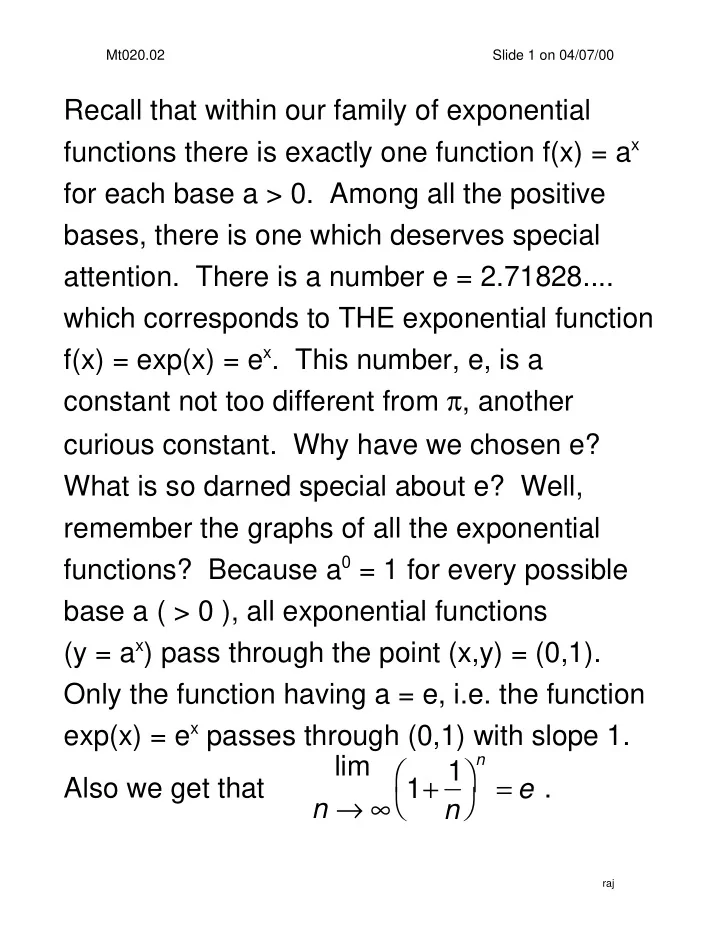

Mt020.02 Slide 1 on 04/07/00 Recall that within our family of exponential functions there is exactly one function f(x) = a x for each base a > 0. Among all the positive bases, there is one which deserves special attention. There is a number e = 2.71828.... which corresponds to THE exponential function f(x) = exp(x) = e x . This number, e, is a constant not too different from π , another curious constant. Why have we chosen e? What is so darned special about e? Well, remember the graphs of all the exponential functions? Because a 0 = 1 for every possible base a ( > 0 ), all exponential functions (y = a x ) pass through the point (x,y) = (0,1). Only the function having a = e, i.e. the function exp(x) = e x passes through (0,1) with slope 1. n lim n → ∞ 1 + 1 = e . Also we get that n raj
Mt020.02 Slide 2 on 04/07/00 Today’s topic is another family of functions, the logarithmic functions. Just as there is one member of the exponential function family for each positive base a (> 0), there is one member of the logarithmic function family, log a (x), for each positive base a (> 0). In fact the pair, a x and log a (x) are intimately related because log a (a x ) = x and also a loga(x) = x This is to say that each of the functions, a x and log a (x) “undoes” the other. Another way to say the same thing is to assert that y = a x is exactly the same as saying log a (y) = x. raj
Mt020.02 Slide 3 on 04/07/00 In English we describe this by saying that w = log a (x) means that w is the exponent that you need to install on a to obtain the value x. Examples: log 2 (64) = 6 log 25 (5) = 0.5 log 10 (1000) = 3 log 27 (3) = 1/3. Notice that when a > 0, we always have a x > 0. As a result of this log a (y) has no meaning whenever y ≤ 0. This translates into “We can never take a logarithm of a non positive quantity.” There are two logarithms which we use more than others, base a = 10 and base a = e. The first, log 10 (x), are called base 10 (or common) raj
Mt020.02 Slide 4 on 04/07/00 logarithms, and the second type, log e (x), are called base e (or natural) logarithms. We have special notations for these special logarithms: log(x) means the common log, log 10 (x) and ln(x) means the natural log, log e (x). Here are some sample problems: Solve for x: ln(e 6 ) = x log(x) = 2 log3(x) = 4 log x (144) = 2 There are several rules for manipulating logs: 1. log b (mn) = log b (m) + log b (n) 2. log b (m/n) = log b (m) - log b (n) 3. log b (a w ) = wlog b (a) 4. log b (1) = 0 and 5. log b (b) = 1 raj
Mt020.02 Slide 5 on 04/07/00 Example: If log(7) = .8451, and log(2) = .3010, then find log(24.5). Solution: log(24.5) = log(49/2) = log(7 2 /2) = log(7 2 ) – log(2) = 2log(7) – log(2) 2 (.8451) – (.3010) = 1.3892 2 ab Simplify: ln a + b e x Simplify: ln x 2 1 + x 2 raj
Mt020.02 Slide 6 on 04/07/00 Solve for x: 8 − 10 3 x + 1 = 13 5 ) = 12 ( Solve for x: 4ln x + 2 7 raj
Recommend
More recommend